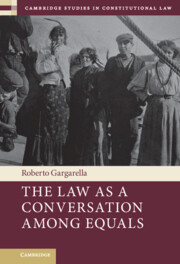Book contents
- The Law As a Conversation among Equals
- Cambridge Studies in Constitutional Law
- The Law As a Conversation among Equals
- Copyright page
- Contents
- Preface
- Acknowledgments
- 1 Constitutionalism and Democracy
- 2 The Law As Conversation among Equals
- 3 “Democratic Dissonance”
- 4 A Constitution Marked by a “Discomfort with Democracy”
- 5 Motivations and Institutions: “If Men Were Angels”
- 6 The Structural Difficulties of Representation
- 7 The Rise and Fall of Popular Control
- 8 The Periodic Vote, or “Electoral Extortion”
- 9 Checks and Balances
- 10 Presidentialism
- 11 Rights
- 12 Social Rights and the “Engine Room”
- 13 Judicial Review
- 14 Constitutional Interpretation
- 15 Constitution Making
- 16 The Birth of Dialogical Constitutionalism
- 17 Why We Care About Dialogue
- 18 “Democratic Erosion”
- 19 The New Deliberative Assemblies
- 20 Conclusion
- Bibliography
- Index
6 - The Structural Difficulties of Representation
Published online by Cambridge University Press: 25 April 2022
- The Law As a Conversation among Equals
- Cambridge Studies in Constitutional Law
- The Law As a Conversation among Equals
- Copyright page
- Contents
- Preface
- Acknowledgments
- 1 Constitutionalism and Democracy
- 2 The Law As Conversation among Equals
- 3 “Democratic Dissonance”
- 4 A Constitution Marked by a “Discomfort with Democracy”
- 5 Motivations and Institutions: “If Men Were Angels”
- 6 The Structural Difficulties of Representation
- 7 The Rise and Fall of Popular Control
- 8 The Periodic Vote, or “Electoral Extortion”
- 9 Checks and Balances
- 10 Presidentialism
- 11 Rights
- 12 Social Rights and the “Engine Room”
- 13 Judicial Review
- 14 Constitutional Interpretation
- 15 Constitution Making
- 16 The Birth of Dialogical Constitutionalism
- 17 Why We Care About Dialogue
- 18 “Democratic Erosion”
- 19 The New Deliberative Assemblies
- 20 Conclusion
- Bibliography
- Index
Summary
In chapter 6, I argue that the representative system that was chosen at the “founding moment” was not thought of as a “second-best” or “necessary evil” system, but rather as a “first option”, preferable to its alternative (some form of direct democracy). Representation—in accordance with “democratic distrust”—was to “filter” or “purify” (instead of “recognizing” or “expressing” or “allowing its refinement through debate”) the citizens’ voice through the sieve of “a chosen group of citizens.” This original representative scheme was explicitly chosen because it was thought that, going back to Madison’s words, the “public voice, spoken by the representatives of the people, is more in line with the public good, than if it had been pronounced by the people themselves, summoned for that purpose.” I argue that representative system was subject to risks that its own proponents recognized, and that with the passage of time materialized: representatives who were “too removed” from their constituents, who fail to recognize the citizens’ demands and needs; who begin to act according to their own interests in disregard for or against the interests of the voters; who form a “class” or “caste” and begin to act primarily for the benefit of that group.
Keywords
Information
- Type
- Chapter
- Information
- The Law As a Conversation among Equals , pp. 82 - 97Publisher: Cambridge University PressPrint publication year: 2022
